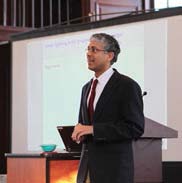
The math department has taken the lead in a renewal process that every department at Milton will conduct, in sequence and at regular intervals. “Ongoing, rigorous, curriculum renewal” is a key tenet of the Strategic Plan adopted by the trustees in January 2013. Heather Sugrue, math department chair, and her colleagues have pioneered the first major example of the process the plan intends.
The energy surge sparked by this process has resulted in many outcomes; Heather established a new speaker series—Pi Talks, pairing math discussion and dessert—and developed Milton’s first math educators conference, which took place February 7, drawing 55 math educators from around New England. Both events brought new perspectives and energetic approaches to math at Milton.
Math and Dessert? Neil Katuna ’05 Kicks Off Pi Talks
“You can’t fudge math,” Neil Katuna ’05 said to students and faculty on November 18, and he thinks that is part of its appeal. Neil shared his experiences of a career in math as part of a new speaker series, Pi Talks: Mathematical Conversations With Dessert, organized by the math department.
Neil believes that “there is beauty in math,” and to illustrate he began with prime numbers, presenting different theorems and proofs. He spent time on the Gauss circle problem, asking students how to estimate the number of integer lattice points there are in a circle centered at the origin and with radius r.
“Mathematics is about asking simple questions and coming up with elegant arguments,” said Neil. “It is great stuff.”
Heather Sugrue, math department chair, hopes the speaker series is a way “for students and adults to gain insights about math that go beyond academia; for example, to see what you can do with math in a job or career.”
Neil discussed an internship with Symantec Research Labs, where he worked on technology that uses algorithms to find malicious or unwanted content on a Web page. He also worked for the National Security Agency on classified problems involving Markov chains—a mathematical system that undergoes transitions from one state to another, where the next state depends on the current state, not the ones preceding it. Neil cited Google’s search engine and text auto correction as examples of technology using Markov chains.
“Mathematics is unique among the disciplines, because you have to have a comprehensive understanding of every theorem,” said Neil.
Today, Neil is an associate for the quantitative research risk analysis group at Loomis, Sayles & Company in Boston. His work today mainly involves linear algebra. Neil majored in pure mathematics at Princeton University and earned his master’s in mathematics at UCLA.
Math Pros Swap Their Best Ideas at Milton
 Dr. Sanjoy Mahajan gave math educators a taste of his “street-fighting mathematics,” a teaching approach that involves the “art of guessing results and solving problems without doing a proof or an exact calculation.” Dr. Mahajan was the keynote speaker at the Math Teachers Conference hosted by Milton’s math department. Fifty-five educators from independent, public, par0chial and charter schools around New England attended the daylong event.
Dr. Sanjoy Mahajan gave math educators a taste of his “street-fighting mathematics,” a teaching approach that involves the “art of guessing results and solving problems without doing a proof or an exact calculation.” Dr. Mahajan was the keynote speaker at the Math Teachers Conference hosted by Milton’s math department. Fifty-five educators from independent, public, par0chial and charter schools around New England attended the daylong event.
Dr. Mahajan argued that rote learning in math leads to students solving problems that they don’t understand. In one study example, students in Grades 4 through 6 were asked to solve 6×3. Students easily knew the answer. But when asked to explain the answer in the form of a story, a typical answer was, “There were six ducks swimming in a pond. Three more ducks arrived and now there were 18 ducks.”
“This is math without meaning. Some students think math is numbers you push around, mix up, and some kind of answer will pop out,” said Dr. Mahajan.
Dr. Mahajan cited studies that show the use of calculators harms student performance. “Students need to turn on their minds, not their calculators. When students rely on calculators, they begin thinking like computers, which is a big problem. Rote learning combines the worst of human and computer thinking. By relying on their minds instead, students will develop intuition and good judgment.”
The rest of the day included 36 short sessions presented by Milton faculty and other conference attendees. Topics included “Using Fathom in Stats,” “Building a Rollercoaster,” and “Integrating Coding into Algebra II.”
“We wanted to create a conference where the main goal was collecting as many good ideas as possible,” said Heather Sugrue, math department chair. “We don’t reflect every day on all the good things that happen in our classrooms, but each of us has at least one idea we like, use often, or want to try out. Sharing these thoughts was an important part of the day.”
Dr. Mahajan is an associate professor of applied science and engineering at Olin College. He is on leave while teaching “Street-Fighting Mathematics” as an edX online course at MIT. He obtained his Ph.D. in theoretical physics from the California Institute of Technology in
1998, and has undergraduate degrees in mathematics from Oxford University and in physics from Stanford University. In 2006 he became an associate director of MIT’s Teaching and Learning Laboratory. His book, Street-Fighting Mathematics: The Art of Educated Guessing and Opportunistic Problem Solving, is available under a Creative Commons Noncommercial ShareAlike license.



